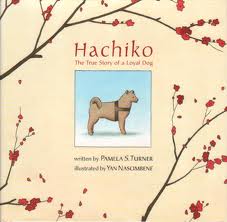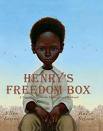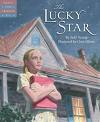Posts tagged ‘setting’
147. Hachiko: The True Story of a Loyal Dog by Pamela S. Turner
 Retell: Everyday Hachiko accompanies his owner, Dr. Ueno to Shibuya Station and patiently awaits his return. When Dr. Ueno doesn’t return one day Hachiko continues to wait at the station…for ten years.
Retell: Everyday Hachiko accompanies his owner, Dr. Ueno to Shibuya Station and patiently awaits his return. When Dr. Ueno doesn’t return one day Hachiko continues to wait at the station…for ten years.
Topics: dogs, Japan, loss, loyalty, Tokyo
Units of Study: Nonfiction, Memoir
Tribes: mutual respect, appreciations/no put downs
Habits of Mind: persistence
Writing Skills: using imagery, describing setting details
My Thoughts: A colleague of mine gave me this book as a gift knowing my connection with Japan. I taught in Japan for three years. Last summer when I visited Japan again I took a trip to Shibuya Station and learned about the story of Hachiko.
I’m not sure if I’d be able to read this book out loud to my class without crying, or making someone else cry. It’s such a beautiful book though. I can see using this as a mentor text for showing how writers describe the setting. Many of my students have difficulty describing anything but the weather. This text shows how a writer takes time to describe the ‘action’ of the setting–the movement of the crowd, the clothes the people are wearing, etc.
17. Grandfather’s Journey by Allen Say
 Retell: Allen Say tells the story of how his grandfather made a home in both a village in Japan and in a city in America.
Retell: Allen Say tells the story of how his grandfather made a home in both a village in Japan and in a city in America.
Topics: grandparents, journeys, San Francisco, Japan, World War II, California, travelling, home, being homesick, family
Units of Study: Memoir, Social Issues
Reading Skills: envisionment, interpretation, inference, making connections
Writing Skills: adding setting details, developing the heart of a story, including reflection, including endings that connect to the beginning
My Thoughts: I think I have a soft spot in my heart for this book because I too get homesick for more than one place. Allen Say’s illustrations remind me of faded photographs and automatically put me into a reflective, sentimental mood. This is a perfect text to use during the Memoir unit. Though it starts out as a story about his grandfather, it ends up being more about the author himself.
15. Henry’s Freedom Box by Ellen Levine
 Retell: This is the true story of Henry “Box” Brown. After his family was sold to another plantation, Henry decides to escape to freedom via the postal service.
Retell: This is the true story of Henry “Box” Brown. After his family was sold to another plantation, Henry decides to escape to freedom via the postal service.
Topics: underground railroad, slavery, perseverance
Units of Study: Nonfiction, Content-Area Reading and Writing, Historical Fiction
Tribes: personal best
Reading Skills: inference, emapthy
Writing Skills: incorporating symbolism, using setting details
My thoughts: I can see why this won a Caldecott Award. The illustrations by Kadir Nelson are larger than life. What’s nice about this book, as well as many biographies written for young readers, is its author’s note. Reading both the story and the author’s note is a nice way to compare narrative and expository nonfiction. Though Henry’s Freedom Box is a biography, I could also see reading this book during a unit on historical fiction to examine how an author tucks in historical details.
8. The Lucky Star by Judy Young
 Retell: Ruth, a young girl growing up during The Great Depression, discovers that her school will be closed down before she enters her 5th grade year. Ruth learns a lesson of perseverance and counting one’s lucky stars.
Retell: Ruth, a young girl growing up during The Great Depression, discovers that her school will be closed down before she enters her 5th grade year. Ruth learns a lesson of perseverance and counting one’s lucky stars.
Topics: The Great Depression, perseverance, family,
Unit of Study: Historical Fiction, Character
Tribes: Personal best
Reading Skills: inference, making connections, prediction
Writing Skills: incorporating setting details, using sensory details
My Thoughts: This book would be a great mentor text during a unit on reading and writing historical fiction. However, I’m tempted to use this at the beginning of the year when I introduce partner work and independence. The Lucky Star teaches that smart people persevere through difficult situations. A closure of a school, or similarly an absence of a teacher or a change in schedule, does not mean that learning stops completely.
2. Three Days on a River In a Red Canoe by Vera B. Williams
Retell: After purchasing a red canoe at a yard sale, a family goes on a three-day canoe trip.
Topics: Family, adventure, camping
Units of Study: Personal Narratives, Launching the Writers Notebook
Tribes: Personal Best
Reading Skills: envisionment, making connections, inference
Writing Skills: incorporating details about setting, using transition words, including sensory details, writing endings that connect to the beginning
My thoughts: This book has great teaching potential. As the marbled cover suggests it reads like someone’s writers notebook. Each page describes a scene from the camping trip. I can imagine using this book when I introduce writers notebooks to my students. Each page is a small moment that could be stretched into a larger story. The colorful, colored pencil drawings will be inspiring for young artists who like to draw pictures with each notebook entry. I plan on using this as a mentor text for students who want to write endings that connect to an earlier scene.

